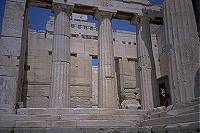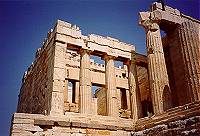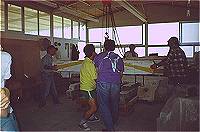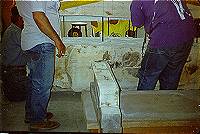ATHENS
Acropolis
Athena Nike
Erechtheum
Parthenon
Propylaia
Acropolis
Museum
South
Slope overview
South Slope lecture
Pnyx
Areopagus
Philopappos
Hill
Agora
Temple
of Olympian Zeus
and Arch of Hadrian
Keramikos
Roman Agora
ATTICA
Brauron
Thorikos
Sounion
Oropos
Marathon
Eleusis
Aigosthena/
Eleutherai
Daphni
Piraeus
MESSENIA
Pylos
Voidokilia
Methoni
Messene
CORINTHIA
Perachora
Corinth
Acrocorinth
Diolkos/Canal
Nemea
Isthmia
BOEOTIA
Thebes
Chaironeia
Orchomenos
Gla
Osios
Loukas
ARGOLID
Epidavros
Nauplion
Mycenae
Argos
Tiryns
ARCADIA
Megalopolis
Overview
Tegea
LACONIA
Mistras
Sparta
Monemvasia
ACHAEA
Kalavrita
NORTHERN
GREECE
scenery
Mount
Olympos
DELPHI
Thermopylae
Naupaktos
Mieza
Edessa
Vergina
Pella
Thessaloniki
ELEIA
Olympia
Chlemoutsi
SARONIC GULF ISLANDS
Aegina
Poros
Hydra
Spetses
CYCLADIC ISLANDS
Santorini
Delos
CRETE
Cnossos
Phaistos
Zakros
|
 |
Dr.
J's Illustrated Propylaia (built 437-432 BC) Lecture
 View of the West entrance to the Acropolis through the Beule
Gate, through which visitors descend from the Acropolis today. Discovered by French
archaeologist Beule in 1852, it was built by the Romans in the 2nd century AD from pieces
(some bearing clear inscriptions) of the choregic monument of Nikias. The central hall of
the Propylaia ("entryway"), through which entry is gained to the Acropolis, is
clearly visible through the doorway. The architect Mnesikles purposely designed the
Propylaia in relationship to the Parthenon, possibly an architectural first. View of the West entrance to the Acropolis through the Beule
Gate, through which visitors descend from the Acropolis today. Discovered by French
archaeologist Beule in 1852, it was built by the Romans in the 2nd century AD from pieces
(some bearing clear inscriptions) of the choregic monument of Nikias. The central hall of
the Propylaia ("entryway"), through which entry is gained to the Acropolis, is
clearly visible through the doorway. The architect Mnesikles purposely designed the
Propylaia in relationship to the Parthenon, possibly an architectural first. |
 View of the Central Hall of the
Propylaia. In 1687, Venetian
bombardments on the Turk-occupied Acropolis destroyed the West facade (which would have
been in the foreground). The Propylaia consists of this central hall and two wings, on the
north (left) and south (right). The West facade was composed of a double row of six
columns, Doric on the outside and Ionic on the inside. View of the Central Hall of the
Propylaia. In 1687, Venetian
bombardments on the Turk-occupied Acropolis destroyed the West facade (which would have
been in the foreground). The Propylaia consists of this central hall and two wings, on the
north (left) and south (right). The West facade was composed of a double row of six
columns, Doric on the outside and Ionic on the inside. |
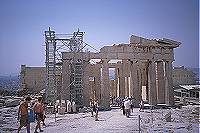 East portico of the
Propylaia. In the 17th century, The Turks' supply of
gunpowder, stored in this portico, was struck by lightning. The ensuing explosion
destroyed the architraves and several Ionic columns. Note the six Doric columns and the
frieze of triglyphs and metopes under the pediment (no sculpture was ever commissioned).
Near this spot (where I stood to snap this photo) stood the 30 foot tall statue of Athena
Promachos, another tribute to Athena's help in the Athenian victory over the Persians.
Pausanias (I.28.2) reports that "the spear-tip and helmet-crest" of the statue
could be seen from the sea and guided Athenian sailors home. East portico of the
Propylaia. In the 17th century, The Turks' supply of
gunpowder, stored in this portico, was struck by lightning. The ensuing explosion
destroyed the architraves and several Ionic columns. Note the six Doric columns and the
frieze of triglyphs and metopes under the pediment (no sculpture was ever commissioned).
Near this spot (where I stood to snap this photo) stood the 30 foot tall statue of Athena
Promachos, another tribute to Athena's help in the Athenian victory over the Persians.
Pausanias (I.28.2) reports that "the spear-tip and helmet-crest" of the statue
could be seen from the sea and guided Athenian sailors home. |
|
Above
are two photos of the North wing of the Propylaia (to
your left as you ascend the grand staircase on your way up through the Propylaia and onto
the sacred rock of the Acropolis), with its portico of three Doric columns in antis
(between pilasters). The doorway leads to the Pinakothiki, or Art Gallery, described in
great detail by Pausanias. Many paintings of familiar scenes from mythology and history
were either hanged or painted on the walls. Since the door is off-center, some scholars
believe that couches lined the walls, offering a place of rest to those who came to offer
sacrifices at the temples on the Acropolis or just to mingle with their countrymen.
|
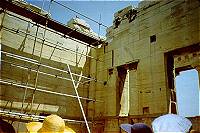 East wall of the North wing of the
Propylaia, damaged during
the Venetian assault on the Acropolis in 1687. The Franks (beginning in 1204) destroyed
the Byzantine floor and built a higher one, so the upper level doors are Frankish, while
the door below is Byzantine. East wall of the North wing of the
Propylaia, damaged during
the Venetian assault on the Acropolis in 1687. The Franks (beginning in 1204) destroyed
the Byzantine floor and built a higher one, so the upper level doors are Frankish, while
the door below is Byzantine. |
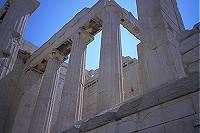 Although the facades of the north and south wings are symmetrical (those
same three Doric columns in antis), the south wing has no room behind it to correspond to
the north's Pinakothiki. Although the facades of the north and south wings are symmetrical (those
same three Doric columns in antis), the south wing has no room behind it to correspond to
the north's Pinakothiki.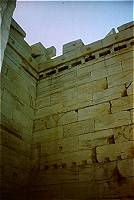 (This south wing is to
your right as your ascend the stairs). Instead, there is a portico that gives direct
access to the little Temple of Athena Nike. Inside that southern portico are visible
rectangular holes near the top of the structure designed for the original wooden slot-roof
(ceiling beams would have fit into each groove); the holes below are intended for the
sloping roof of a later Medieval church. (This south wing is to
your right as your ascend the stairs). Instead, there is a portico that gives direct
access to the little Temple of Athena Nike. Inside that southern portico are visible
rectangular holes near the top of the structure designed for the original wooden slot-roof
(ceiling beams would have fit into each groove); the holes below are intended for the
sloping roof of a later Medieval church. |
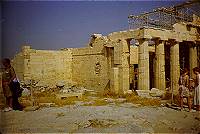 The photo on the left shows the east portico of the Propylaia
(the doorway through which you actually enter the Acropolis proper). Note that the lifting
bosses - outcroppings of marble used as grips for positioning the huge blocks - are quite
prominent. Although meant to be shorn away after they have served their purpose, since the
building was never finished, the bosses remain. Curiously, it became quite fashionable
after this to leave the lifting bosses intact as part of the finished design of a building
- perhaps due to the distinctiveness of this model! On the right, Mr. The photo on the left shows the east portico of the Propylaia
(the doorway through which you actually enter the Acropolis proper). Note that the lifting
bosses - outcroppings of marble used as grips for positioning the huge blocks - are quite
prominent. Although meant to be shorn away after they have served their purpose, since the
building was never finished, the bosses remain. Curiously, it became quite fashionable
after this to leave the lifting bosses intact as part of the finished design of a building
- perhaps due to the distinctiveness of this model! On the right, Mr.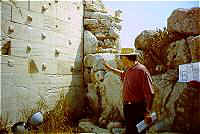 Tanoulas, architect in charge of the Propylaia Restoration
Project, points to the joining of the outside SE corner of the South Wing and the much
older Mycenean wall. There is a Medieval addition to the wall in the corner. And boss
close-ups!
Tanoulas, architect in charge of the Propylaia Restoration
Project, points to the joining of the outside SE corner of the South Wing and the much
older Mycenean wall. There is a Medieval addition to the wall in the corner. And boss
close-ups! |
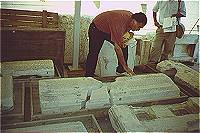 Mr. Tanoulas points out grievous faults caused by an earlier
reconstruction attempt by Balanos which modern conservators must repair before the current
work of restoration can occur. On the left Mr. Tanoulas points out grievous faults caused by an earlier
reconstruction attempt by Balanos which modern conservators must repair before the current
work of restoration can occur. On the left 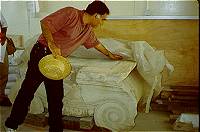 Mr. Tanoulas points to holes drilled in the marble to aid in lifting them.
These were foolishly left open to the air, and pooled water damaged the marble. He also
used iron clamps, which subsequently rusted, expanding and cracking the marble. In
antiquity they knew better - they coated their iron clamps with lead. Balanos also erred
by "reconstructing" this Ionic column capital from marble fragments really
belonging to four distinct column capitals. Mr. Tanoulas points to holes drilled in the marble to aid in lifting them.
These were foolishly left open to the air, and pooled water damaged the marble. He also
used iron clamps, which subsequently rusted, expanding and cracking the marble. In
antiquity they knew better - they coated their iron clamps with lead. Balanos also erred
by "reconstructing" this Ionic column capital from marble fragments really
belonging to four distinct column capitals. |
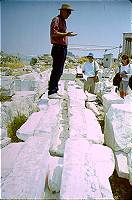 Faced with almost insurmountable difficulties when it comes to
putting this giant jigsaw puzzle back together again, it is a joy to find pieces that
clearly belong together: Faced with almost insurmountable difficulties when it comes to
putting this giant jigsaw puzzle back together again, it is a joy to find pieces that
clearly belong together: on the left is one long
beam that has been broken into 5 fragments. On the right is a marble graveyard of the c.
1000 ceiling pieces (mostly) unused by Balanos in his ill-destined reconstruction
attempt. on the left is one long
beam that has been broken into 5 fragments. On the right is a marble graveyard of the c.
1000 ceiling pieces (mostly) unused by Balanos in his ill-destined reconstruction
attempt. |
|
A series of three photos showing
conservators reconstructing a piece of the Propylaia entablature: (1) a crane is used to
hoist one piece of marble onto another for refitting; (2) titanium rods have replaced any
iron implanted by Balanos and cement has been poured into any remaining holes; (3) a
perfect fit!
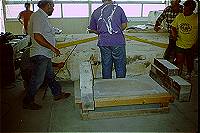
|
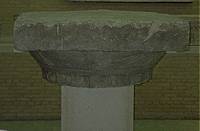
Doric capital from eastern porch (BM)
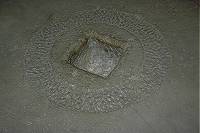
close-up of dowel hole with chisel marks from Ionic column drum from inside Propylaia
(BM)
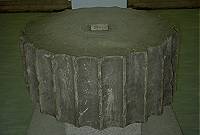
that Ionic column drum (BM)

wall block from the Propylaia (BM)
Scientific American:
Exhibit: The Digital Museum: June 1, 1998
3D Reconstruction of the Propylaia
Computer-generated
reconstruction of the Propylaia (Kyoto Institute of Technology, 1987)
|




